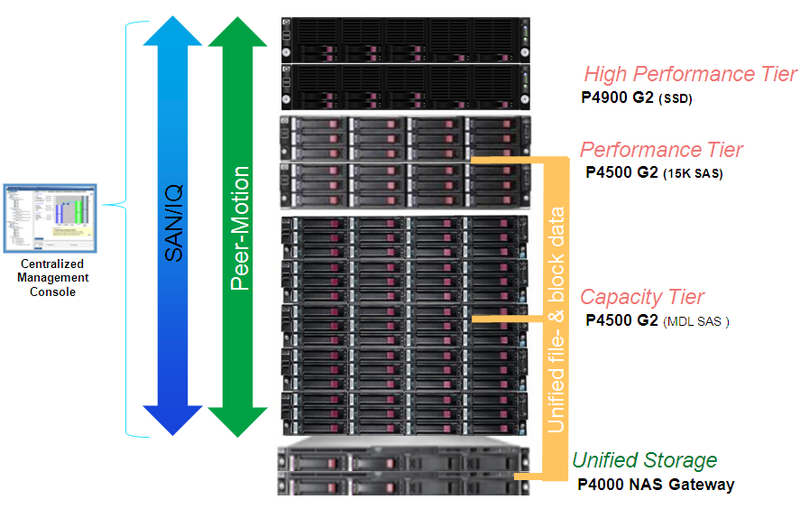"Lefty" came out with solid-state disks
Prices for solid-state drives are constantly falling, and if two years ago these drives were used only as an option for high-end storage systems, then today you can find arrays from different manufacturers on the market, entirely built on SSDs.

In early June, HP introduced its first all-solid-state solid-state array (all solid state storage system) of the P4000 series (LeftHand) for iSCSI storage networks. From traditional arrays with two controllers, it differs in almost linear scalability. Usually, due to the limited bandwidth in such arrays, it does not make sense to install more than four to eight solid-state drives, since two controllers are unable to provide I / O for more SSDs. The new P4900 (like the rest of the P4000) scales by adding nodes to the cluster and its IOPS grows linearly as the nodes grow, so it can provide the necessary throughput for several dozen SSDs (up to 256 SSDs in maximum configuration). For example, in the minimal two-node configuration, the P4900 provides 70,000 IOPS, and to get the same level of performance when using the fastest 15K SAS hard drives, you will need to build a 24-node P4000 cluster!
P4900 is equipped with 400-gigabyte solid-state drives with multi-level recording MLC Enterprise Flash. Sixteen such disks are installed in the basic two-node module P4900, and eight in the expansion shelf. The base module is equipped with four 10 Gigabit Ethernet ports and four more one-gigabit network ports, a RAID controller and a two-gigabyte cache with a backup battery.
As you know, the main drawback of solid-state drives relative to traditional hard drives is the limited number of write cycles. So that the owner of the P4900 does not lose the data stored on the array due to the failure of the solid-state disk, HP supplies the SMARTSSD Wear Gauge utility with the array, which tracks its wear according to its name. This utility gives a warning in advance on the array management console that the solid-state drive will soon exhaust its resource and should be replaced as soon as possible. Although, as you know, LeftHand can safely lose both disks and entire nodes without stopping the service.
')

Solid-state P4900 can be used both separately and as part of a multi-level storage P4000, consisting of different types of clusters - on SSD, fast and slow SAS drives. These clusters are grouped together and managed from a single console. The administrator can move virtual disks between such clusters without shutting down applications.

In early June, HP introduced its first all-solid-state solid-state array (all solid state storage system) of the P4000 series (LeftHand) for iSCSI storage networks. From traditional arrays with two controllers, it differs in almost linear scalability. Usually, due to the limited bandwidth in such arrays, it does not make sense to install more than four to eight solid-state drives, since two controllers are unable to provide I / O for more SSDs. The new P4900 (like the rest of the P4000) scales by adding nodes to the cluster and its IOPS grows linearly as the nodes grow, so it can provide the necessary throughput for several dozen SSDs (up to 256 SSDs in maximum configuration). For example, in the minimal two-node configuration, the P4900 provides 70,000 IOPS, and to get the same level of performance when using the fastest 15K SAS hard drives, you will need to build a 24-node P4000 cluster!
P4900 is equipped with 400-gigabyte solid-state drives with multi-level recording MLC Enterprise Flash. Sixteen such disks are installed in the basic two-node module P4900, and eight in the expansion shelf. The base module is equipped with four 10 Gigabit Ethernet ports and four more one-gigabit network ports, a RAID controller and a two-gigabyte cache with a backup battery.
As you know, the main drawback of solid-state drives relative to traditional hard drives is the limited number of write cycles. So that the owner of the P4900 does not lose the data stored on the array due to the failure of the solid-state disk, HP supplies the SMARTSSD Wear Gauge utility with the array, which tracks its wear according to its name. This utility gives a warning in advance on the array management console that the solid-state drive will soon exhaust its resource and should be replaced as soon as possible. Although, as you know, LeftHand can safely lose both disks and entire nodes without stopping the service.
')

Solid-state P4900 can be used both separately and as part of a multi-level storage P4000, consisting of different types of clusters - on SSD, fast and slow SAS drives. These clusters are grouped together and managed from a single console. The administrator can move virtual disks between such clusters without shutting down applications.
Source: https://habr.com/ru/post/147206/
All Articles